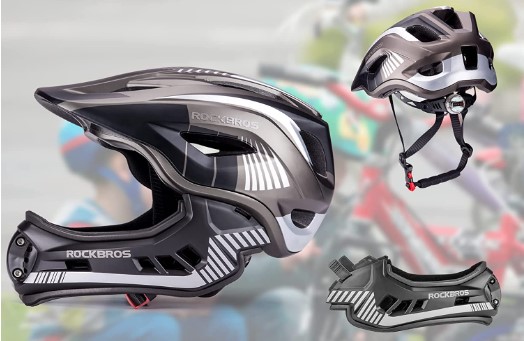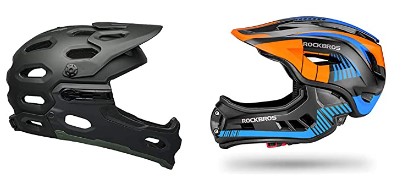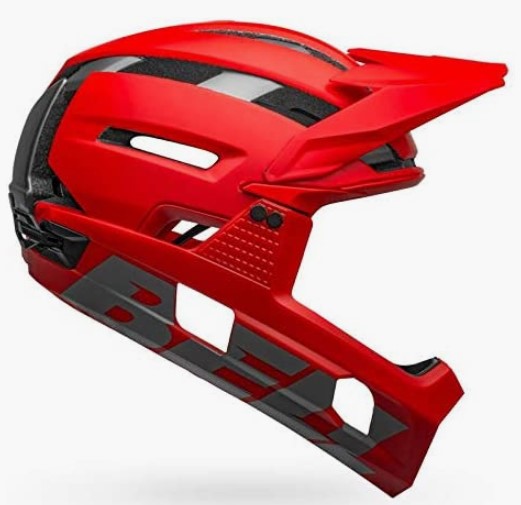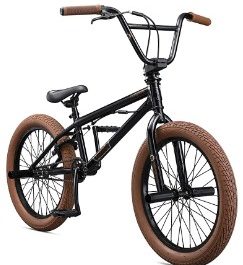Full face helmets have gained popularity over the years. Maybe you have heard of them and wondered, are full face helmets safer?
Full face helmets have a few advantages that make them safer than their open-face siblings. Among them are head and face protection, cool feel, extra cushioning, and protection from debris and bugs, and distracting noise.
That doesn’t mean they don’t have a few concerns. For example, these helmets are heavy and thus can be uncomfortable and may limit your vision and hearing on the road.
This guide will discuss the benefits of full-face helmets, their drawbacks, and what to look for when buying one. Later I will answer some questions regarding the topic.
Let’s get started!

Why Are Full Face Helmets Safer? (The Pros)
Wearing a full-face helmet comes with numerous advantages. Below are the benefits of a full-face helmet.
1. Extra Protection to The Head and Face
The Injury Epidemiology study shows that a full-face helmet protects your face and head from severe injuries during a crash.
Compared to open-face helmets that offer less coverage, full-face helmets cover your head top, the back of the head, above the ears, the chin, and the entire face. That means that a full-face helmet gives you full head and face coverage.
Since it shelters your face, it protects it from natural elements like snow, wind, and rain. Even better, since your nose and mouth are kept safe, you don’t inhale pollen, dangerous vapors, and dust, especially if you have an allergy.
2. Cool Feel
One thing most cyclists like is a helmet that keeps them cool. Well, that’s what a full-face helmet promises. They have an in-built vent system and breath guard that ensures excellent airflow to your head.
So, you have no doubts that your head stays cool on every ride when sweating profusely or riding in the hot summer. In short, full-face helmets are great options for those who like riding in extreme weather.
3. Offer More Cushioning
Full-face helmets are thicker compared to other standard helmets. Though this comes with its share of concerns, safety is vital. Being thicker means they are heavier, which can be uncomfortable for some because of the added weight on the neck.
On the brighter side, the thick material of full-face helmets translates to more cushioning, thus reducing injuries during an accident.
4. Protection from Debris and Bugs
As we know, open-face helmets don’t entirely cover your face. Imagine riding your mountain bike in the forest or on mountainous trails with flying branches, debris, or bugs. It will indeed be a bad experience.
That’s where full-face helmets shine. Since they give you full face coverage, they protect your delicate facial skin from debris and bugs that can cause irritation and bites.
5. Protects Against Distracting Noises
We all like concentrating when taking our rides. But what if you are a commuter who rides through noisy neighborhoods or congested towns? A full-face helmet will block all the distracting noises like people yelling at you, making sure you concentrate.
But don’t confuse these distracting noises with non-harmful ones. With your full-face helmets on, you will hear sirens, traffic sounds, and horns from other cyclists. That keeps you alert and safe.
Why Full Face Helmets May Be Unsafe (The Cons)
Since we have seen that full-face helmets are safe and give you ample protection to the head and face, only some people like them. Some dislike them for the reasons below:
· They are Heavy and Thus Can Be Uncomfortable On the Head
As stated earlier, full-face helmets come with thicker materials making them heavy. The extra weight may be a burden for your neck to handle.
However, if this seems an issue to you, nowadays, most helmet manufacturers are now making lighter full-face helmets, some even lighter than open-face options. So, when searching for one, shop wisely.
· May Obstruct Your Vision
Most full-face helmets come with in-built visors, which may fog up, especially if it’s poorly ventilated (has fewer vents). The fogging may hinder your road visibility, resulting in an accident or fall.
The other issue is that you have a limited view as you only need to concentrate forward. This can be disturbing, especially if there’s an alarming issue coming from the back or sideways.
· May Limit Hearing
Though full-face helmets block hearing distracting noises helping you concentrate on your ride, it may be opposite to some with impaired hearing.
Since full-face helmets cover your ears, it may limit hearing other cyclists’ horns, sirens, or traffic sounds. That can be catastrophic since it can lead to falls or accidents that can lead to severe injury or, in some cases, death.

Things to Consider When Buying a Full Face Helmet
Now that it’s clear that full-face helmets do more good than harm, let’s discuss things to look for when buying one.
1. The Correct Fit
There isn’t anything more annoying than purchasing a helmet that doesn’t fit. The bad news is that not only will it be a waste of money, but it’s recommended not to ride in such a helmet.
To get the right fit, you must measure your head (the large part above the eyebrows) using a tape measure. After knowing your head circumference, use the table below to get a size that fits snugly.
| Helmet Size | Head Circumference |
| Extra Small (XS) | Below 51 cm |
| Small (S) | 51 – 55 cm |
| Medium (M) | 55 – 59 cm |
| Large (L) | 59 – 63 cm |
| Extra Large (EL) | 63 – 65 cm |
| Adjustable fit | One size fits all |
2. Certification
Another thing you cannot overlook is the helmet certification. You should know if a given helmet meets the helmet standards. That is because some of the full-face helmets in the market aren’t certified and are thus unsafe.
Some of the bodies certifying bike helmets include:
- DOT (US Department of Transportation) – DOT regulates all helmets in the USA. So, if you live in the US, ensure you buy a helmet with a DOT mark.
- Snell – Now, if you are in other parts of the world, your helmet should have a Snell mark. Snell works independently, tests, regulates, and certifies bicycle and motorcycle helmets worldwide.
- ECE (Economic Commission for Europe) – If you are in Europe, ECE is a legal body that regulates, tests, and certifies helmets around Europe.
3. Technology
Nowadays, helmet manufacturers use different technologies in manufacturing bike helmets. So, checking the technology before buying a helmet is a good idea.
Some of the two standard technology that most manufacturers use include:
- MIPS (Multi-Directional Impact Protection System) – MIPS is among the leading, and most manufacturers use it to protect your head against rotational forces during a crash, thus lessening injury.
- Bontrager Wavecel Technology – Wavecel technology uses a thick mass of polyester that helps absorb direct and rotational impacts. Therefore, it’s the most effective technology that most experts recommend.
4. Your Riding Style
Before choosing a bike helmet, you should ensure that it suits your riding style. If you are a mountain bike diehard who likes spending most of your time in the forest or on rocky terrains, you will no doubt want a more aggressive full-face helmet.
Similarly, urban commuters who use the road more often should get a more comfortable full-face helmet.
On the other hand, if you like riding your bike faster, your ideal full-face helmet should be more aerodynamic to resist wind drag.
Best Full Face Helmet for Kids
If you want the safest full-face helmet for your kid aged 3 – 16, nothing beats the ROCKBROS Kids Full Face Helmet (Check on Amazon).
This full-face helmet comes in many color choices, and its outer shell is made of durable polycarbonate material. It has an EPS foam interior that absorbs impacts and shock during a fall.
It also has 12 events ensuring your kid receives enough airflow, and the best part is that it’s lighter, considering it weighs only 0.84 lbs.
Best Full Face Helmet for Adults
Regarding adult helmets, nothing compares to the BELL Super Air R MIPS Full Face Helmet (Check on Amazon).
This helmet is suitable for mountain bike riders and comes with an in-molding polycarbonate outer shell with a progress EPS foam layer. It is MIPS certified and thus can curb low-speed and high-speed rotational impacts.
It comes in 3 head sizes (small, which fits heads of 52 – 56 cm, medium size, 55 – 59 cm, and large size suitable for heads within 58 – 62 cm). To ensure it is well-ventilated, it has 18 vents and an additional eight on the chin, thus making it breathable enough.

People Also Ask
1. Are Full Face Bike Helmets Safer?
As seen, full-face bike helmets are the safest helmets there are in the market. It gives you full coverage of the head and face. So, your ears, eyes, and mouth remain protected from natural elements like sun, rain, and snow.
2. Are Full Face Helmets Hot?
The debate of full face helmets being hot or not goes on. However, since most full-face helmets come with vents and additional ones on the chin area, we can say they are not as hot as some assume.
In summary, are full face helmets safer?
Generally, full face helmets are safer compared to open-face helmets. Unlike the latter, full face helmets give you full coverage protecting your head and face. That reduces the severity of a head and facial injury during a crash, protects against insects and bugs, and blocks away the noise to allow you to concentrate.
That, however, doesn’t negate concerns such as extra weight and reduced visibility and hearing, which may happen. But when comparing the safety risks and the benefits these helmets promise, they are overall safe.
Relevant:

